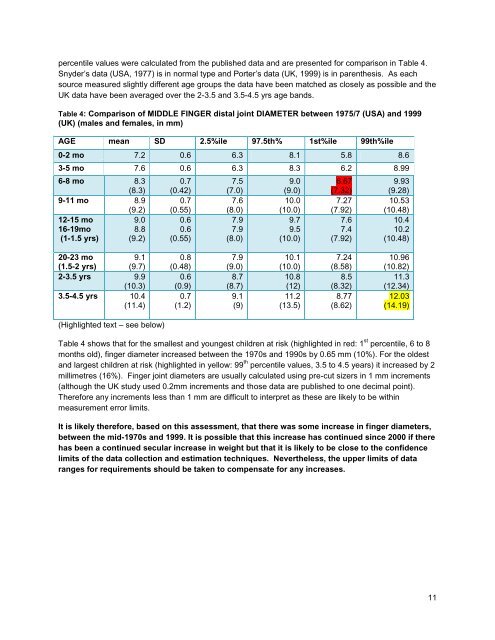Requirements for finger entrapment in European safety ... - ANEC
Requirements for finger entrapment in European safety ... - ANEC
Requirements for finger entrapment in European safety ... - ANEC
You also want an ePaper? Increase the reach of your titles
YUMPU automatically turns print PDFs into web optimized ePapers that Google loves.
percentile values were calculated from the published data and are presented <strong>for</strong> comparison <strong>in</strong> Table 4.<br />
Snyder’s data (USA, 1977) is <strong>in</strong> normal type and Porter’s data (UK, 1999) is <strong>in</strong> parenthesis. As each<br />
source measured slightly different age groups the data have been matched as closely as possible and the<br />
UK data have been averaged over the 2-3.5 and 3.5-4.5 yrs age bands.<br />
Table 4: Comparison of MIDDLE FINGER distal jo<strong>in</strong>t DIAMETER between 1975/7 (USA) and 1999<br />
(UK) (males and females, <strong>in</strong> mm)<br />
AGE mean SD 2.5%ile 97.5th% 1st%ile 99th%ile<br />
0-2 mo 7.2 0.6 6.3 8.1 5.8 8.6<br />
3-5 mo 7.6 0.6 6.3 8.3 6.2 8.99<br />
6-8 mo 8.3<br />
(8.3)<br />
9-11 mo 8.9<br />
(9.2)<br />
12-15 mo<br />
9.0<br />
16-19mo<br />
8.8<br />
(1-1.5 yrs) (9.2)<br />
0.7<br />
(0.42)<br />
0.7<br />
(0.55)<br />
0.6<br />
0.6<br />
(0.55)<br />
7.5<br />
(7.0)<br />
7.6<br />
(8.0)<br />
7.9<br />
7.9<br />
(8.0)<br />
9.0<br />
(9.0)<br />
10.0<br />
(10.0)<br />
9.7<br />
9.5<br />
(10.0)<br />
6.67<br />
(7.32)<br />
7.27<br />
(7.92)<br />
7.6<br />
7.4<br />
(7.92)<br />
9.93<br />
(9.28)<br />
10.53<br />
(10.48)<br />
10.4<br />
10.2<br />
(10.48)<br />
20-23 mo<br />
9.1<br />
(1.5-2 yrs) (9.7)<br />
2-3.5 yrs 9.9<br />
(10.3)<br />
3.5-4.5 yrs 10.4<br />
(11.4)<br />
0.8<br />
(0.48)<br />
0.6<br />
(0.9)<br />
0.7<br />
(1.2)<br />
7.9<br />
(9.0)<br />
8.7<br />
(8.7)<br />
9.1<br />
(9)<br />
10.1<br />
(10.0)<br />
10.8<br />
(12)<br />
11.2<br />
(13.5)<br />
7.24<br />
(8.58)<br />
8.5<br />
(8.32)<br />
8.77<br />
(8.62)<br />
10.96<br />
(10.82)<br />
11.3<br />
(12.34)<br />
12.03<br />
(14.19)<br />
(Highlighted text – see below)<br />
Table 4 shows that <strong>for</strong> the smallest and youngest children at risk (highlighted <strong>in</strong> red: 1 st percentile, 6 to 8<br />
months old), <strong>f<strong>in</strong>ger</strong> diameter <strong>in</strong>creased between the 1970s and 1990s by 0.65 mm (10%). For the oldest<br />
and largest children at risk (highlighted <strong>in</strong> yellow: 99 th percentile values, 3.5 to 4.5 years) it <strong>in</strong>creased by 2<br />
millimetres (16%). F<strong>in</strong>ger jo<strong>in</strong>t diameters are usually calculated us<strong>in</strong>g pre-cut sizers <strong>in</strong> 1 mm <strong>in</strong>crements<br />
(although the UK study used 0.2mm <strong>in</strong>crements and those data are published to one decimal po<strong>in</strong>t).<br />
There<strong>for</strong>e any <strong>in</strong>crements less than 1 mm are difficult to <strong>in</strong>terpret as these are likely to be with<strong>in</strong><br />
measurement error limits.<br />
It is likely there<strong>for</strong>e, based on this assessment, that there was some <strong>in</strong>crease <strong>in</strong> <strong>f<strong>in</strong>ger</strong> diameters,<br />
between the mid-1970s and 1999. It is possible that this <strong>in</strong>crease has cont<strong>in</strong>ued s<strong>in</strong>ce 2000 if there<br />
has been a cont<strong>in</strong>ued secular <strong>in</strong>crease <strong>in</strong> weight but that it is likely to be close to the confidence<br />
limits of the data collection and estimation techniques. Nevertheless, the upper limits of data<br />
ranges <strong>for</strong> requirements should be taken to compensate <strong>for</strong> any <strong>in</strong>creases.<br />
11
















